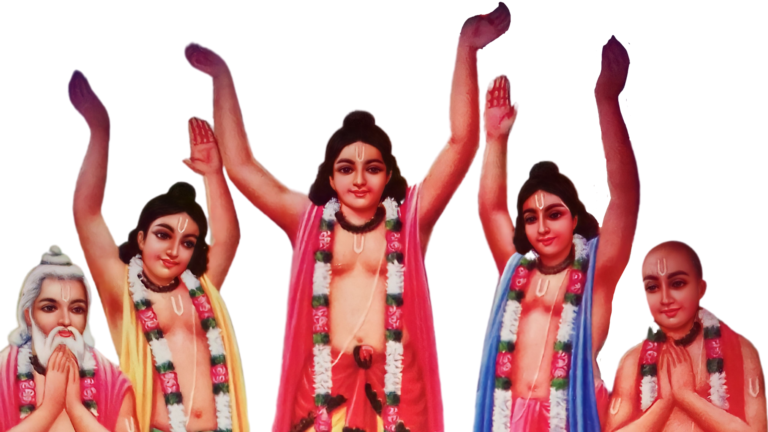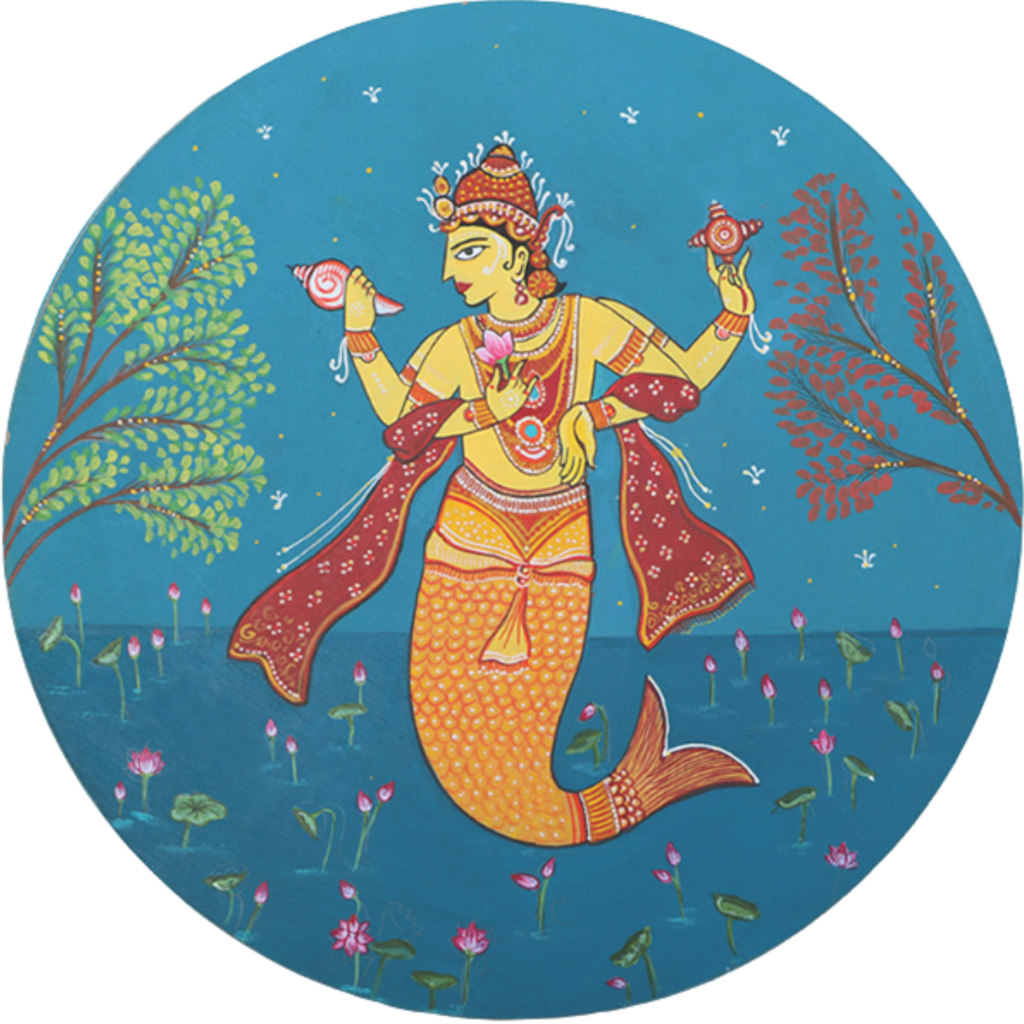The teachings of Bhagavāna KalkiRām Śrī Śrī Śrī Satya Ananta Mādhaba

- Obey the elders: This principle emphasizes the importance of respecting and following the guidance of those who are more experienced and knowledgeable. In Vedic culture, elders are seen as the repositories of wisdom and knowledge, and their advice is highly valued.
- Have patience: Patience is a virtue that is highly valued in Vedic tradition. It involves the ability to endure hardship or suffering without becoming upset or angry, and it is seen as a necessary quality for spiritual growth and development.
- Have affection towards all: This principle emphasizes the importance of cultivating a loving and compassionate attitude towards all beings. It is based on the belief that all beings are interconnected and that by showing kindness and compassion to others, we can create a more harmonious and peaceful world.
- Practice ‘Upavas’ (Fasting): ‘Upavas’ refers to staying near God rather than fasting or abstinence of food. It advocates the regular practice of being God-conscious and always seeking His divine presence.
- Also, the Lord strongly advocates giving up the feeling of “I”, “mine”, “you”, and “yours”. These feelings are associated with a sense of attachment and identification with the material world, which will lead to the development of ahankara or false ego. False ego is a type of pride that arises from a sense of self-importance and superiority over others. It is an obstacle to spiritual growth because it creates a sense of separation between oneself and others and reinforces the illusion of individuality and materialism. By transcending the limitations of the ego and identifying with the spiritual essence within us and others, we can achieve a higher state of consciousness and connect with the divine.
As per the instructions of the Lord, every person following His 'dhara' (religious path) must
- Perform Tri-sandhya AND
- Read at least 1 ‘Adhyay‘ (Chapter) of ‘Shreemad Bhagwat Mahapurana’ every day.
The word ‘Tri-Sandhya’ literally means ‘three junctions’ and refers to the three times these prayers are to be performed.
Early Morning (Pratah sandhya) – Transition periods between night and early morning (approximately 4 AM – 6 AM)
Noon (Madhyahnikam sandhya) – The transition period between day and noon (approximately 12:00 PM to 1 PM)
Evening (Saayam Sandhya) – The transition period between sunset and night (approximately 5:00 to 6:30 PM)
Note: The ‘Sandhya‘ time will vary based on the location.
Therefore, Tri-sandhya is to be performed three times a day – once during each of these periods.
Sincere practice will purify the mind and body and strengthen the connection with the divine.
Tri-Sandhya Prayer Instructions:
1. Chant ‘OM’ 3 times
‘Om’ is a sacred sound and symbol in Sanatana Dharma, representing the primordial sound of creation and the ultimate reality of the universe.
2. Chant ‘Gayatri Mantra’ 3 times
“Om Bhur Bhuva Svaha
Tat Savitur Varenyam
Bhargo Devasya Dhimahi
Dhiyo Yo Nah Prachodayat”
The meaning of the Gayatri Mantra is as follows:
Om:
The primordial sound, representing the ultimate reality of the universe.
Bhur:
The physical world or the material realm.
Bhuva:
The mental or astral realm.
Svaha:
The celestial or spiritual realm.
Tat:
That, referring to the divine power.
Savitur:
The sun, representing the source of all life and consciousness.
Varenyam:
The most excellent or desirable.
Bhargo:
The radiant splendor, representing the purity of the divine power.
Devasya:
Of the deity.
Dhimahi:
We meditate upon.
Dhiyo:
The intellect or the power of discrimination.
Yo:
Which.
Nah:
Our.
Prachodayat:
May enlighten or inspire.
By chanting this mantra with devotion and focus, one can seek the blessings of the divine power and attain inner peace, wisdom, and spiritual growth. The Gayatri Mantra is also believed to have a purifying effect on the mind and body, helping to remove negative energy and promote positive vibrations.
3. “OM sac-cid-ānanda-rūpāya viśvotpaty-ādi-hetave
tāpa-traya-vināśāya śrī-kṛṣṇāya vayaḿ namaḥ
śrī-kṛṣṇāya vayaḿ namaḥ
śrī-kṛṣṇāya vayaḿ namaḥ
śrī-kṛṣṇāya vayaḿ namaḥ”
Author: Vyasadeva
Book Name: Padma Purana
“OM”, I offer my humble obeisance to Lord Krishna, who is of the nature of eternal knowledge, existence, and bliss, the cause of the creation of the universe. He is the cause of the creation, maintenance and destruction of the universe and the destroyer of the three types of miseries. He is known as Vāsudeva and is the destroyer of the threefold miseries.
The phrase “śrī-kṛṣṇāya vayaḿ namaḥ” is repeated three times at the end of the verse, as a form of reverence and devotion to Lord Krishna.
4.
Sarva Mangalye Mangalye Shive Sarvartha Sadhike,
Sharanye Tryambake Gauri Narayani Namostute.
“O Auspicious One, who brings auspiciousness to all, who is ever victorious, who removes all obstacles, we bow down to You, O Mother Gauri, who is the consort of Lord Shiva and the embodiment of all that is noble.”
5.
“Sharanagata Dinarta Paritrana Parayane,
Sarvasyarti Hare Devi Narayani Namostute.”
This mantra is a prayer to Devi Narayani, the divine mother who is believed to protect her devotees and remove their suffering. The mantra acknowledges the devotee’s sense of surrender and refuge-seeking and asks Devi Narayani to protect them and remove all their afflictions. By reciting this mantra with faith and devotion, one can seek the grace and blessings of Devi Narayani and find solace and strength to face the challenges of life.
6.
“Sharanagata Dinarta Paritrana Parayane,
Sarvasyarti Hare Devi Narayani Namostute.”
Narayani Namostute
Narayani Namostute
Narayani Namostute
This mantra is a prayer to Devi Narayani, the divine mother who is believed to protect her devotees and remove their suffering. The mantra acknowledges the devotee’s sense of surrender and refuge-seeking and asks Devi Narayani to protect them and remove all their afflictions. By reciting this mantra with faith and devotion, one can seek the grace and blessings of Devi Narayani and find solace and strength to face the challenges of life.
7.
“Gurur Brahma, Gurur Vishnuh, Gurur Devo Maheshvarah,
Gurur Sakshat Param Brahma, Tasmai Shri Gurave Namah.”
This mantra is a salutation to the Guru or the spiritual teacher who is regarded as the embodiment of the divine. The mantra recognizes the Guru as the representative of the Hindu Trinity – Brahma, Vishnu, and Shiva – who are considered the creator, preserver, and destroyer of the universe, respectively. The mantra also acknowledges the Guru as the manifestation of the ultimate reality or the Absolute Truth (Param Brahma). Since Lord Kalki or Lord Krishna is now here with us on Earth and He is regarded as “Jagadguru” meaning “the spiritual teacher of the world”, this prayer when offered to Lord Kalki and who Himself is the supreme teacher will accelerate our spiritual journey and be instrumental to obtain the grace of Kalki Avatar.
8.
“Ajnaana Timiraandhasya Jnaanaanjana Shalaakayaa,
Chakssuruunmilitam Yena Tasmai Shri Gurave Namah.”
By reciting this mantra, one expresses their gratitude and reverence towards the Guru for removing the veil of ignorance and guiding them towards the path of knowledge and enlightenment
9.
“Akhanda Mandalaakaaram Vyaptam Yena Charaacharam,
Tatpadam Darshitam Yena Tasmai Shri Gurave Namah.”
Tasmai Shri Gurave Namah
Tasmai Shri Gurave Namah
Tasmai Shri Gurave Namah
This mantra is a salutation to the Guru or the spiritual teacher who is regarded as the one who reveals the ultimate reality or the Absolute Truth to the disciple. The mantra describes the Guru as the one who pervades the entire universe, both animate and inanimate, and who reveals the divine truth to the disciple.
10.
“Akhandamandalaakaram vyaptam yena caracharam
Tatpadam darshitam yena tasmai Sri Gurave namah”
tasmai Sri Gurave namah
tasmai Sri Gurave namah
tasmai Sri Gurave namah
“I offer my salutations to the noble Guru, who has shown me the ultimate truth, by which the entire universe, consisting of animate and inanimate things, is pervaded, and which is formless and eternal.”
After reciting the above mantras with devotion, as part of Tri-Sandhya we need to offer the below prayers:
- “Dashavatar Stotram” (hymn in Sanskrit language that praises the ten incarnations of Lord Vishnu)
- “Durga Madhaba Stuti” (hymn in Odia language that is in praise of Goddess Durga),
- “Vishnu nka Saula Naam”(16 Names of Lord Vishnu)
- “Madhaba Naam” (Chant the one-word Mantra “MADHABA” which is the most auspicious name during this transition period from Kali Yuga to Ananta Yuga)
- Kalki Mahamantra (The Mahamantra associated with Lord Kalki which will help the devotee connect with the divine energy and grace of Lord Kalki, who is regarded as the ultimate destroyer of evil and the restorer of righteousness and dharma (righteousness).
- Jai Ghosh (‘Jai Ghosh’ itself means ‘victory call’ or ‘call to victory.’ It is an expression of devotion and reverence for Lord Kalki and is recited at the end of Tri-Sandhya).
Note: Click the above verses links to know their meanings.


